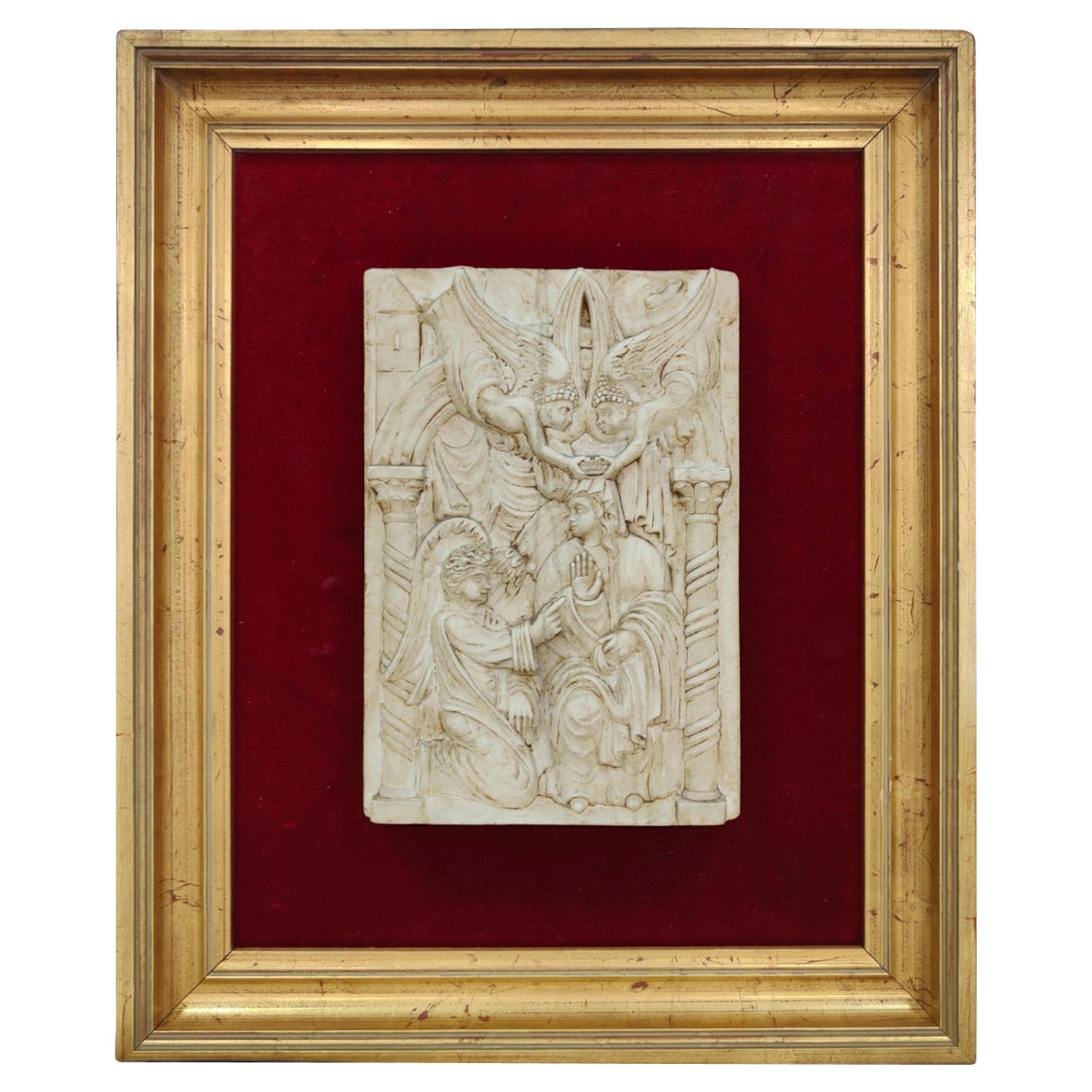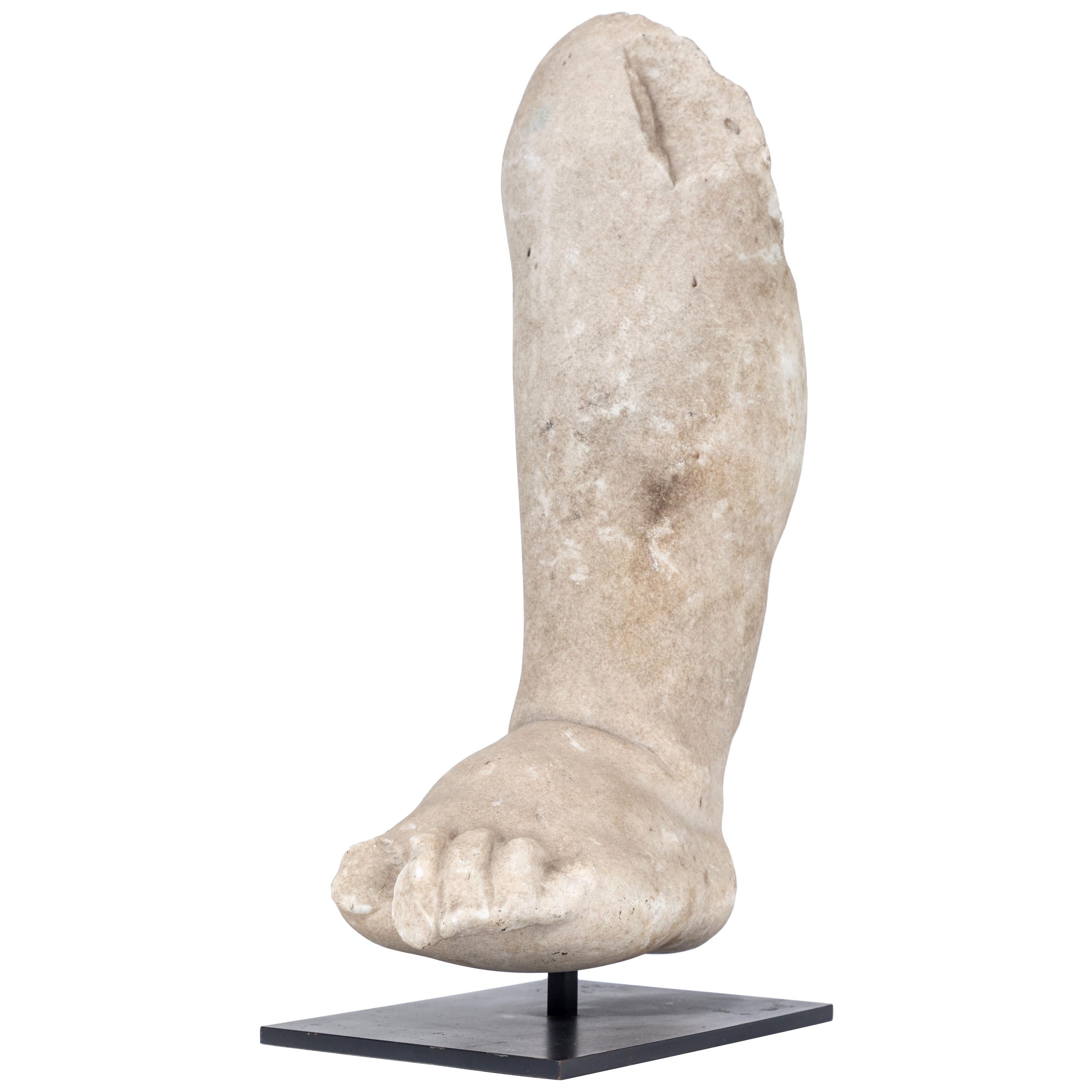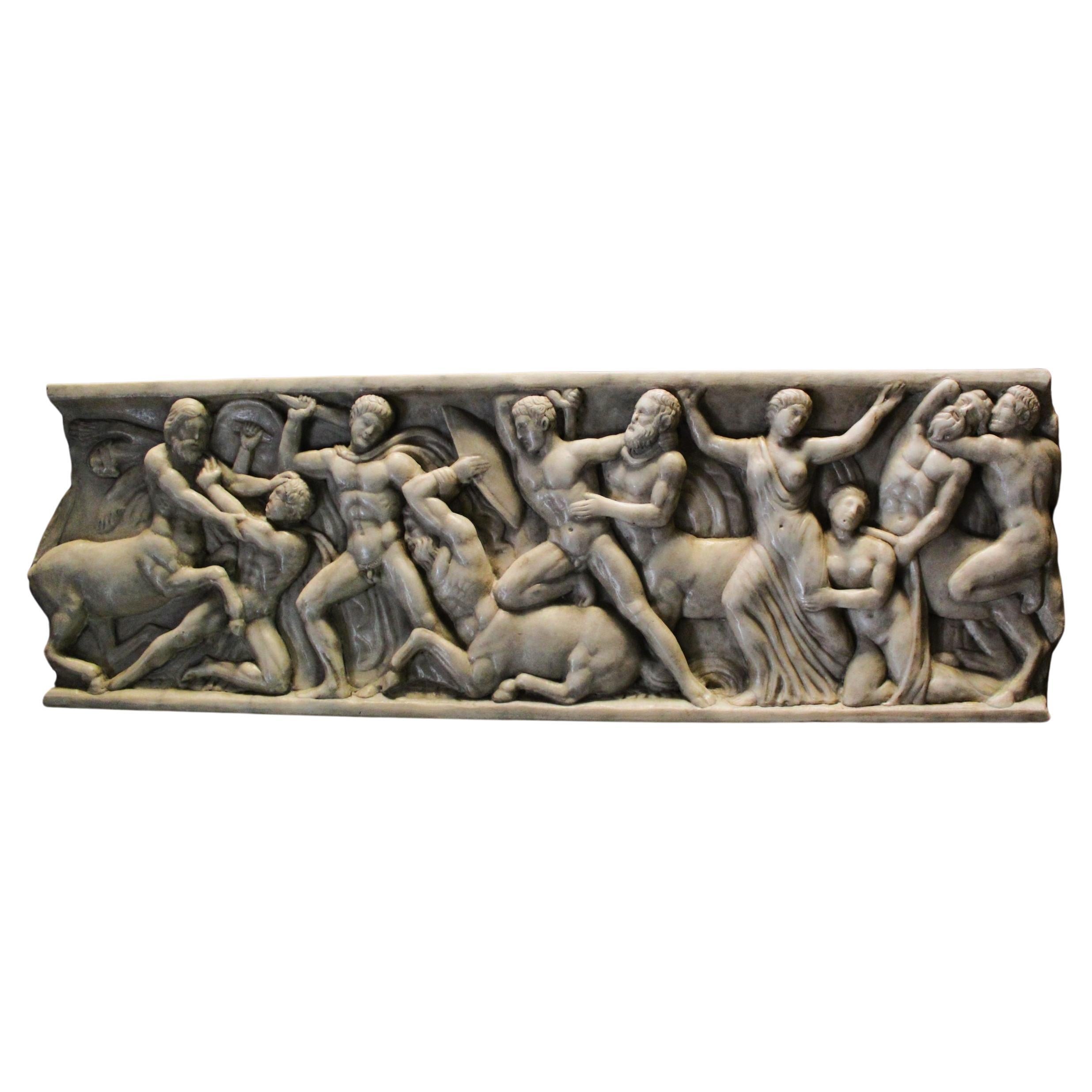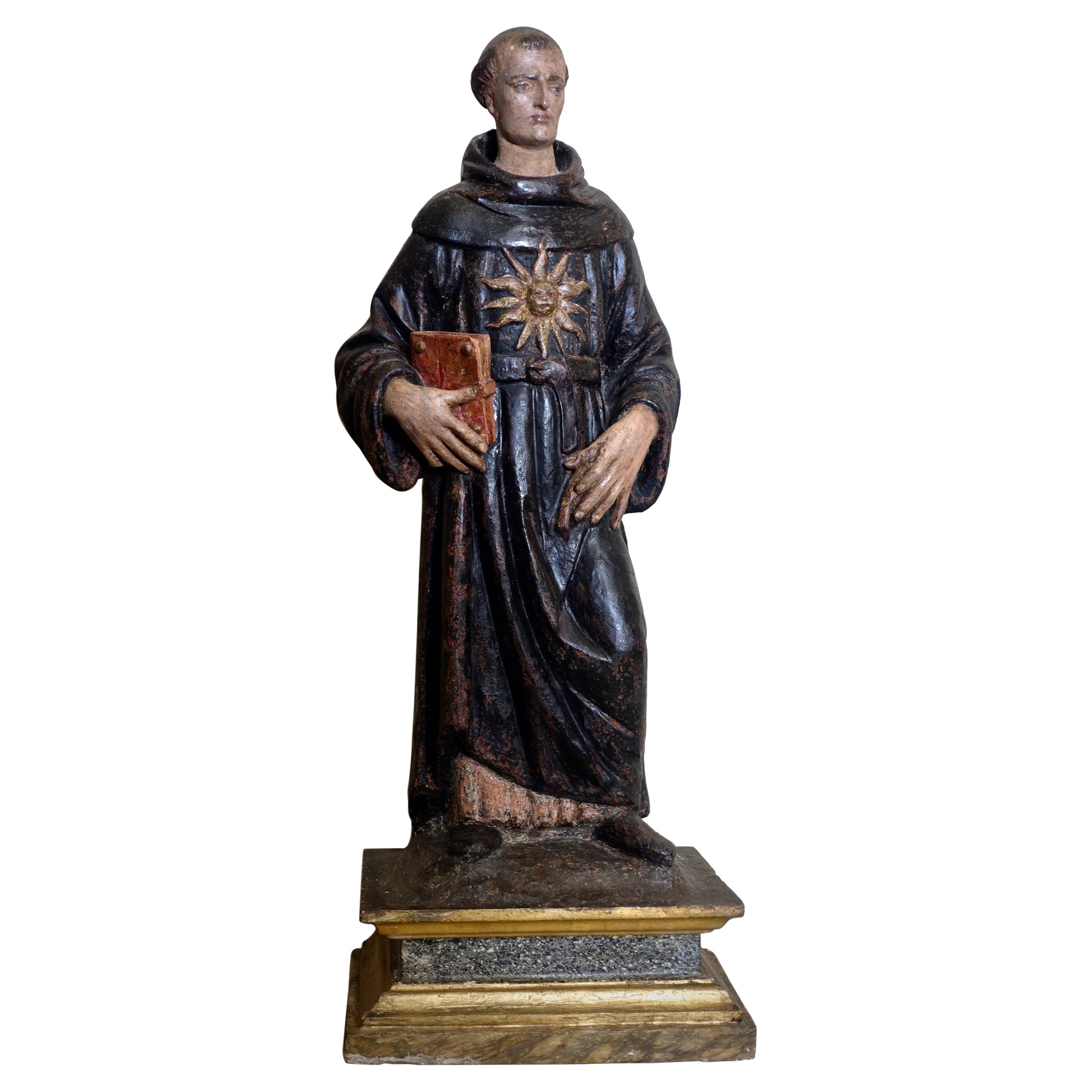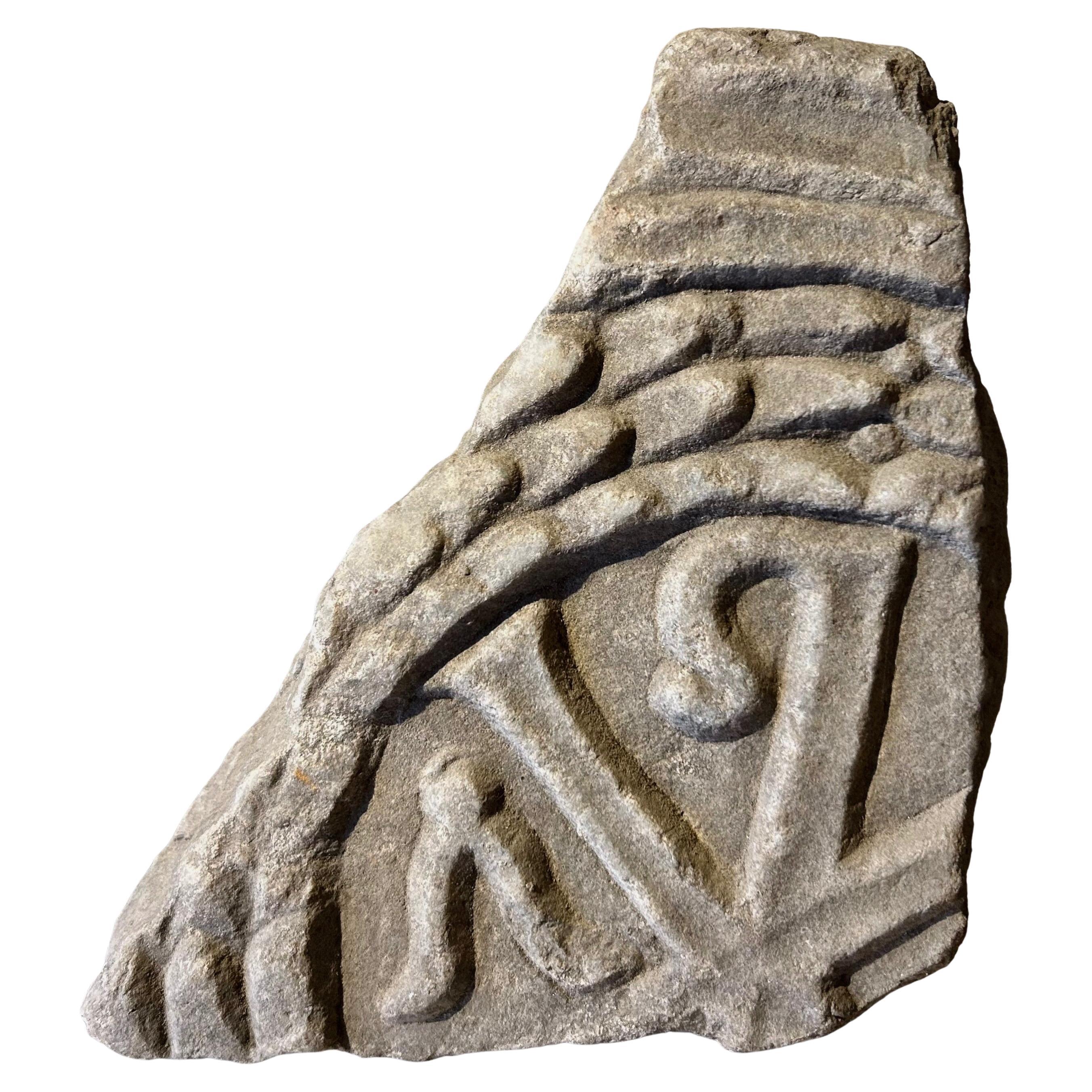Items Similar to Renaissance Marble Relief - Emilia Romagna, 1470-80
Want more images or videos?
Request additional images or videos from the seller
1 of 5
Renaissance Marble Relief - Emilia Romagna, 1470-80
About the Item
Renaissance Marble Relief
Emilia Romagna, Faenza ? 1470-80
H 30,2 x L 33 x P 3,5 cm
The carved marble relief depicts the Virgin accompanied by a winged cherub standing behind her. The relief is set within a concave circle, where the Virgin's face occupies the deepest part. The lower portion of the panel rests on two vegetal volutes terminating in a compartmentalized rectangular base. The contemplative Virgin, with partially open eyelids, turns her gaze away from the viewer as she slightly tilts to her left; the slight inclination of the Virgin's face and the cherub appearing to her right create a triangular composition that harmoniously fits within the enclosing circle. The veil surrounding the Madonna's face is formed by almost fluid parallel folds; the fabrics and their undulations serve to attract and guide the viewer's gaze, creating plastic volumes that catch the light and deepen into shadows, thus structuring the representation's space. The drapery of the veil here serves to magnify Mary and amplify her presence.
Typical of late Quattrocento sculpture in central-northern Italy is the extraordinary craftsmanship of carved marble, which is folded and elegantly fluid. The reduced format of the panel suggests its origin either as a small anconette linked to private devotion or as a predella of a marble altarpiece. The work exhibits typical stylistic elements of Florentine culture from the early Renaissance in the Virgin's proud posture and in the judicious use of relief, deeper in the Virgin's face and less pronounced in the face of the angel in the background.
This relief was created during a pivotal period, the second half of the 15th century, considered the pinnacle of the Renaissance, when the new style invented by Donatello and the Florentine sculptors of the early 15th century reached maturity. Influenced by Donatello's teachings, this relief demonstrates a renewed attention to works of Antiquity. It is still attributed to Donatello to have shown that such models could effectively be adopted not only in subjects "à l'antique" but also in sacred subjects. The work embodies the main themes and trends that pervade Italy during the second half of the Quattrocento. It is imbued with serene grace; the pursuit of balance is manifested in an art intended for reflection and the pleasure of patrons. Ancient models, calmer and more harmonious, are brought up to date thanks to the emphasis placed on inner and emotional processes. The classicism of ancient sources and subjects is transcended by a poetic vision of beauty. This new stylistic orientation, characterized by soft and peaceful forms, draws inspiration from antiquity while quickly being surpassed by a great freedom of personal reinterpretation. Sculpture develops the search for a new harmony that transcends the naturalism of gestures and extreme sentiments. To move and convince become the two aims of religious sculpture in the second half of the Quattrocento, aiming to touch the intimate springs of the viewer's soul.
- Dimensions:Height: 9.45 in (24 cm)Width: 13 in (33 cm)Depth: 1.38 in (3.5 cm)
- Style:Renaissance (Of the Period)
- Materials and Techniques:
- Place of Origin:
- Period:
- Date of Manufacture:15th century
- Condition:Wear consistent with age and use.
- Seller Location:Bruxelles, BE
- Reference Number:1stDibs: LU6666239618922
About the Seller
5.0
Vetted Seller
These experienced sellers undergo a comprehensive evaluation by our team of in-house experts.
1stDibs seller since 2022
6 sales on 1stDibs
Typical response time: <1 hour
- ShippingRetrieving quote...Ships From: Bruxelles, Belgium
- Return PolicyA return for this item may be initiated within 3 days of delivery.
More From This SellerView All
- Agnolo di Polo Firenze 1470 - Arezzo 1528' - Saint Nicholas of TolentinoLocated in Bruxelles, BEAgnolo di Polo (Firenze 1470 - Arezzo 1528) Saint Nicholas of Tolentino Around 1510-1520 Painted and gilded terracotta 55.5 x 24 x 16.5 cm San Nicholas de Tolentino is represe...Category
Antique 16th Century Italian Renaissance Figurative Sculptures
MaterialsTerracotta
- Marble Roman relief representing a ChristogramLocated in Bruxelles, BEMarble Roman relief representing a Christogram Roman relief - 4th century 25 x 22 x 8 cm Provenance : Collection of the Château de B. À Nevers by Georges C.S., scholar born in 1833 and deceased in 1909 The entire castle and its collections were acquired in 1938 by the current owners of the estate A christogram is a monogram or combination of letters that forms an abreviation for the name of Jesus Christ. This rare fragment combines chi (X) and rho (P), the first two letters of Christ's name in Greek and it is one of the oldest and most popular early christian symbol. The monogram of Christ, or chrismon, is also a powerful symbol of imperial victory: it appeared to Emperor Constantine the Great before his battle against Maxentius in ad 312, promising victory in the name of Christ. In Plato's Timaeus, it is explained that the two bands which form the "world soul" (anima mundi...Category
Antique 15th Century and Earlier Italian Classical Roman Figurative Scul...
MaterialsMarble
- Cercle of Jacopo della Pila - Marble relief depicting a winged CherubLocated in Bruxelles, BECercle of Jacopo della Pila (Lombard, in Naples 1471-1502) Marble relief depicting a winged Cherub Naples, second half of15th century 40 x 57 x 12 cm Exquisitely carved, this relief portrays a winged cherub with cascading hair and delicate features. The cherub's plump, smooth countenance, rounded cheeks, outlined lips, and finely drawn nose emanate a sense of tenderness. The quadrangular module, is adorned with a carved frame. The relief ascends gradually, transitioning from the low relief of the wings to the high relief of the head. The rectangular frame and the subtly curved form of the artwork suggest that the relief likely adorned the upper part of an arch or a vaulted chapel. The type is that of the perspective room with a coffered ceiling decorated with figures of winged cherubs, which is found in various Neapolitan chapels of the 15th century. Coffered ceilings attest to the recovery of antiquity and the search for luxury in Renaissance architecture, first in Florence, then in Rome and Naples. The majority of the numerous family chapels and tombs built during the late fifteenth century in south of Italy employ the new formal vocabulary of the Florentine Renaissance in a self-confident manner that permitted a broad spectrum of variations. The escalating admiration for the classical world, coupled with the development of perspective, significantly contributed to the Renaissance endorsement of coffered ceilings. This artistic and constructive device drew inspiration from the intricate marble patterns observed in historical landmarks such as the Arch of Titus, the Temple of Vesta in Tivoli, the Pantheon, and the Basilica of Maxentius. A distilled product of both mathematical and artistic cultures, deeply scrutinizing the ancient world, the coffered ceiling plays a vital role in the perspective construction of space with its regular and directional geometry. The motif of the coffered ceiling decorated with cherubs in relief was introduced in Naples by Francesco Laurana in the plastic decoration of the Arch of Castelnuovo. Laurana's impact on the art scene in the south of Italy was profound. The introduction of the winged cherub into the region's artistic vocabulary bridged the gap between the classical and the contemporary, creating a synthesis that resonated with both aesthetic and spiritual sensibilities. His influence extended beyond the immediate visual appeal, shaping the cultural identity of the Renaissance in southern Italy. Although the plastic decoration of the Arch of Castelnuovo cannot certainly be ascribed to a mature Renaissance style, it was precisely on this occasion that the sculptors who worked there could get to know and export throughout the Italian peninsula that type of "Florentine classicism" which, even in the 15th century Naples, was conditioned by the Burgundian culture imported into the Kingdom by Alfonso of Aragon himself, with artists called from Spain and Northern Europe. The coffered ceiling, with its geometric patterns and Laurana's winged cherubs nestled within, became a symbol of refinement and cultural sophistication. The relief sculptures, carefully integrated into the overall design, transformed the ceiling into a celestial realm, inviting viewers to contemplate the divine while immersed in the grandeur of the Renaissance space. Similar winged cherubs appears also in the Naples cathedral. Within the renowned Succorpo Chapel, a mesmerizing marble coffered ceiling adorned with cherubs epitomizes the splendor of the Neapolitan Renaissance. The interplay of light and shadow on the textured surface of the marble coffered ceiling introduces an ethereal dimension, providing an immersive visual experience for observers. The geometric precision and the repeated patterns, reminiscent of classical motifs, establish a sense of harmony and balance that has become the hallmark of the Neapolitan interpretation of Florentine Renaissance aesthetics. Although probably intended to be admired from a distance, this cherub is intricately detailed and exquisitely rendered: the face and hair are elegantly outlined and the feathers are textured through juxtaposed lines. The marble, both figurative and decorative, adheres to the principles of balance and restrained ornamentation typical of the « Florentine Classicism ». Harmonious shapes and gracefully orchestrated curves , rooted in the classical repertoire, converge to evoke a sense of ethereal beauty. The surface displays the masterful use of a chisel to intricately carve the feathers and facial features, creating an almost abstract quality. This work is a testament to a sculptor of great skill and rich figurative knowledge, seamlessly blending classical firmness in contours with a refined treatment of the marble's surface. The combination of tradition and innovation point to a stylistic idiom from Lombardy, in particular we can find some comparaisons with the works of Jacopo della Pila, sculptor of Lombard origin working in Naples in the second half of the 15th century. He is documented there between 1471 and 1502, and is a protagonist of the Aragon Renaissance in the second half of the Quattrocento, together with the other great Northern sculptor active in the kingdom, Domenico Gagini. the first commission he received dates back to August 9, 1471, when Jacopo publicly committed to sculpting the funerary monument of Archbishop Nicola Piscicelli to be placed in the Cathedral of Salerno. The last known work is an altar ordered on July 29, 1502, by the noble Jacopo Rocco for the church of San Lorenzo Maggiore in Naples. Between these two chronological extremes (1471-1502), we must place the fervent activity of the artist, who had trained in Rome, perhaps under the guidance of Paolo Romano but also engaged in dialogue with other major artists of the city, especially Isaia da Pisa. He enriched his experience in Naples, initially drawing inspiration from the works of Domenico Gagini and later from the Tuscan masterpieces of Antonio Rossellino and Benedetto da Maiano destined for the church of Santa Maria di Monteoliveto. Jacopo della Pila's artistic personality is thus based on a complex interplay of influences, contributing to the definition of a highly personal style. Close comparaison can be made between our cherub and the winged angels reliefs...Category
Antique 15th Century and Earlier Italian Renaissance Figurative Sculptures
MaterialsMarble
- renaissance wooden candelabrum and painted cross - Umbria, 16th centuryLocated in Bruxelles, BEBase of a carved wooden candelabrum, polychrome and gilded; cross painted on both sides. Umbria or Tuscany, 16th century 136 x 43,5 x 30 cm (The cross and the base of the candelabrum were later assembled) The base of the candelabrum is intricately carved and adorned with polychrome and gilded finishes. The shafts take on the shape of balusters reminiscent of ancient columns, feature ornate foliage decorations, garlands and winged cherub faces. The feet are crafted in the likeness of lion paws. The base is further embellished with depictions of four saint martyrs, among them Saint Barbara and Saint Catherine of Alexandria. The plasticity of the figures, outlined with strong contour lines, the clear and vibrant colors, are stylistic elements linked to the Umbrian tradition of the sixteenth century.The precisely defined and elegant drawing, along with the clear color palette applied with refined chiaroscuro modulations, became the signature of a style that would leave a lasting mark on the era to come. This is exemplified by a preference for vibrant, multicolored images, accentuated in this case by the use of red and pink in the saint's attire. A notable addition, introduced later, is a polylobed cross painted on both sides. On one side, the Crucifixion is vividly portrayed:The treatment of the corpus itself is in line with High Medieval practice, emphasizing pathos by showing Jesus dead, his arms sagging from the weight of the body. The upper section displaying a pelican pecks at her breast to feed her young with her own blood; a symbol of the sacrifice of Christ on the cross whose body and blood similarly nourishes the celebrant during Mass. The lower part depicts Golgotha. On the reverse side, the Resurrection is artistically presented in a Renaissance iconography, reminiscent of the renowned composition painted by Piero della Francesca, now housed in the Civic Museum of Sansepolcro. In terms of composition, with the frontal depiction of Christ holding the banner, this motif became particularly widespread in central Italy, spanning from Tuscany to Umbria throughout the 16th century.. The double-sided construction suggests that it may also have been carried in liturgical processions. In Umbria from the 14th century, the use of portable crosses painted on both sides had become a widespread practice, aimed at satisfying the monastic clientele that had significantly increased following the establishment of new religious communities. The earliest surviving Tuscan painted crucifix represent Christ as Christus Triumphans, or the “Triumphant Christ” with his head up and eyes open. This form was supplanted in the 13th century with the Christus Patiens, or “Suffering Christ” type who is shown often with his head fallen on his shoulder and his eyes closed, as In our cross. The iconography of the suffering Christ appears to have developed out of a new interest in Christ’s human nature, the development of the feast of Corpus Christi and with increased importance given to the Eucharist. The process of humanizing the figure of Christ reaches its peak with the abandonment of all the previous expressive conventions in favor of more realistic details we can observe in this Crucifix, such as the swollen belly, the arms stretched to the limit of muscle tearing, the body falling heavily forward, the abundant blood on the wounds, and the cross firmly embedded in the rock of Calvary. It's worth noting that Renaissance candelabra...Category
Antique 16th Century Italian Renaissance Figurative Sculptures
MaterialsWood, Giltwood
- Marble Lion, Périgord, 17th CenturyLocated in Bruxelles, BEMarble lion white marble France, probably Périgord, 17th century Small marble lion wearing a coat of arms pendant with the engraved date, ...Category
Antique 17th Century French Renaissance Animal Sculptures
MaterialsMarble
- Large Terracotta Relief - Lombardy, First Half of 17th CenturyLocated in Bruxelles, BELarge Terracotta relief of the flight into Egypt Lombardy, first half of 17th century Painted terracotta 91 x 85 x 11,5 cm This event in the early life of Christ is recounted i...Category
Antique 17th Century Italian Baroque Figurative Sculptures
MaterialsTerracotta
You May Also Like
- 19th Century Renaissance Marble ReliefBy Europa AntiquesLocated in Madrid, ES19th century Renaissance marble relief. The relief is carved to the Renaissance taste and is in very good condition. It is framed in a later frame ...Category
Antique 19th Century Italian Renaissance Figurative Sculptures
MaterialsMarble
- Male Profile Relief in Marble Italian Renaissance of the 17th Century with VideoBy Europa AntiquesLocated in Madrid, ESMale profile relief in Marble Italian Renaissance of the 17th century Measures: 18cm - Height 27 Cm Good condition for the time.Category
Antique 17th Century Italian Renaissance Busts
MaterialsMarble
- Renaissance Era, Marble Fragment of a LegLocated in Newport Beach, CAChic, 15th Century, Roman marble fragment of a left foot and calf mounted on a custom iron stand.Category
Antique 15th Century and Earlier Italian Renaissance Figurative Sculptures
MaterialsCarrara Marble
- Marble bas-reliefLocated in Rome, ITMarble bas-relief. ADDITIONAL PHOTOS, INFORMATION OF THE LOT AND SHIPPING INFORMATION CAN BE REQUEST BY SENDING AN EMAIL. Indicative shipping costs in Italy: 170€ and Europe: 320€. T...Category
Mid-20th Century Italian Figurative Sculptures
MaterialsStone, Marble
- Renaissance Style Marble Figure of Sleeping ChildBy François DuquesnoyLocated in London, GBThis marble figure of a sleeping child was crafted around 1800 in the style of François Duquesnoy, a sculptor active in Italy in the early 17th Century....Category
Antique Early 1800s Italian Renaissance Figurative Sculptures
MaterialsMarble
- Ancient marble high reliefLocated in Rome, ITAncient high relief in Siena yellow marble. ADDITIONAL PHOTOS, INFORMATION OF THE LOT AND QUOTE FOR SHIPPING COST CAN BE REQUEST BY SENDING AN EMAIL, ULTERIORI FOTO, INFORMAZIONI SUL...Category
Mid-20th Century Figurative Sculptures
MaterialsMarble
Recently Viewed
View AllMore Ways To Browse
Marble Relief Mary
Marble Virgin Mary
Renaissance Office
Light Renaissance
Virgin Mary Figurative
Renaissance Carved Religious
Italian Marble Religious Sculpture
Carved Marble Angel Sculpture
Relief Italy
Cherub Renaissance
Draperies Panel
Antique Drapery Panels
Marble Circle Light
Neopolitan Bronze
Nu Feminin
Porcelain Clown Dolls Vintage
Push Sled
Ratto Delle Sabine
